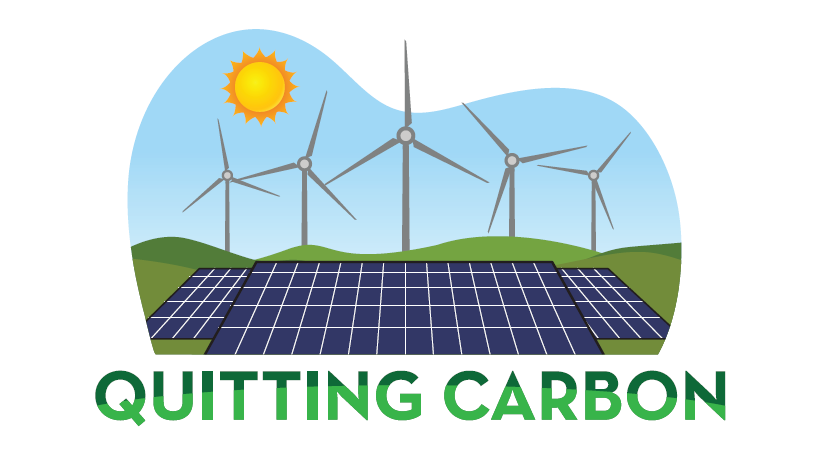What I’m reading: Explaining Trump's war on wind and solar, electric aviation milestone, all-electric buildings update, and more

Quitting Carbon is a 100% subscriber-funded publication. To support my work, please consider becoming a paid subscriber or making a one-time donation.
With this What I’m Reading newsletter, we’re back to its regular schedule. I aim to publish these roundups every other Friday. With my recent travels, I had to shift things around a bit.
As I previewed in my last roundup, I was recently in Corvallis, Oregon, to report on a marine energy conference put on by the Pacific Ocean Energy Trust (POET) and the University Marine Energy Research Community (UMERC). In case you missed it, I published a dispatch from the conference, on my visit to the PacWave South testing facility. I have another short item from the conference below.
Before we get to the roundup, I have a quick favor to ask. If you’ve come to appreciate this newsletter, please consider sending it to a friend or colleague or sharing a link to a favorite Quitting Carbon story on social media. Google’s AI tools are making it harder for media outlets to benefit from search traffic (because of "AI Overviews," fewer Google browsers are clicking through to news stories), so recommendations from committed readers like you are more important than ever in helping others discover Quitting Carbon. Thank you!
And, thanks, as always, for reading.
Explaining the Trump administration's war against wind and solar power
Last week, I shared a link on Bluesky to a U.S. Department of Energy press release announcing financial support for a series of hydropower R&D projects. I noted in my post that it affirmed something that came up time and again at the POET/UMERC marine energy conference in Oregon.
"At least so far," I wrote, "Trump's antipathy for renewables has not been directed at hydropower and marine energy."
The two sectors appear to have been embraced as part of the Trump administration’s American “energy dominance” agenda. But why?
"Their antipathy appears limited to the technologies that pose a near-term threat to an unnecessary gas expansion. Existing hydro has mostly already been uprated. SMR, conventional nuke, new hydro, marine kinetic energy sources will all take years to develop. Wind, solar, storage – not so much," wrote Kristina Costa, the White House director for Inflation Reduction Act implementation in the Biden administration, in a reply to my post.
A marine energy industry veteran said something very similar to me at the Oregon conference (during an informal, off-the-record breakfast conversation). The Trump administration is abiding the marine energy industry, the source said, because wind and solar power threaten fossil gas’ standing as the largest single-source of electricity on the U.S. grid today – wave energy, for now, does not.
So, does it explain the Trump administration’s all-out assault on wind and solar power I wrote about last week?
That is, can it be traced to the oil and gas industry’s political spending on behalf of Trump and Republicans in Congress, and a determination to slow the energy transition? Or is it tied to Trump’s notorious loathing of wind power?
You may recall that during the 2024 campaign Trump pledged to do the oil and gas industry’s bidding if it raised $1 billion to help return him to the White House. The New York Times tracked $75 million in direct donations to Trump and his campaign committees from the oil industry during the 2024 election cycle.
On the other hand, there is Trump promising in an August 20 Truth Social post: "We will not approve wind or farmer destroying Solar."
During a three-and-a-half-hour-long (!) Cabinet meeting last week, Trump said, "I'm trying to have people learn about wind real fast. And I think I've done a good job but not good enough because some countries are still trying and they're destroying themselves. I hope they get back to fossil fuel."
"Windmills – we're just not gonna allow them. They are ruining our country," he added.
In the end, I suspect it’s a bit of both.
The oil and gas industry is wielding its influence with sympathetic GOP lawmakers and Trump administration officials. And members of Trump’s obscenely obsequious Cabinet are tripping over themselves to adopt policies or act in ways that win them the Dear Leader’s favor.
Regarding the latter, we learned on Wednesday, thanks to reporting from the New York Times' Maxine Joselow, Lisa Friedman, and Brad Plumer, that direction in the Trump administration's war against offshore wind is coming directly from the top, led by White House Chief of Staff Susie Wiles and Deputy Chief of Staff Stephen Miller.
Trump administration cancels $427 million grant for Humboldt offshore wind terminal
In the column I published last Friday, I argued that the Trump administration’s war on wind and solar power will continue until the targeted industries mount a legal and political counterattack strong enough to act as a deterrent.
Shortly after that column went live, the assault continued. The U.S. Department of Transportation canceled $679 million in federal funding for a dozen infrastructure projects intended to support offshore wind development.
The biggest loser in the purge by far was the Humboldt Bay Harbor, Recreation, and Conservation District, which had been awarded a $427-million grant by the Biden administration in January 2024 to support construction of the Humboldt Bay Offshore Wind and Heavy Lift Marine Terminal on a spit of land just west of downtown Eureka in Northern California. Plans call for the facility to be the primary assembly and staging area for floating turbines that will be towed to wind farms about 30 miles offshore Humboldt Bay.

“The Harbor District is currently working with the State and other partners to determine our next steps. … We have every intention of continuing the project,” the harbor district responded in a statement.


Proposed site for the Humboldt Bay Offshore Wind and Heavy Lift Marine Terminal on the Samoa Peninsula in Northern California. Here's what it looked like from the town of Samoa when I visited in August 2022. Credit: Justin Gerdes.
Assault on offshore wind continues ... but resistance emerges
The Trump administration didn't stop with the offshore wind infrastructure grant terminations. Over the past week, the U.S. Department of Justice filed motions indicating that the Interior Department planned to reconsider the Biden administration's approvals for SouthCoast Wind and New England Wind 1 and 2, wind farms planned for waters offshore Massachusetts. For a rundown of all the Trump administration's anti-wind actions, check out the comprehensive timeline Heatmap's Emily Pontecorvo published yesterday.
According to a source at one of Washington, D.C.’s most influential energy lobbying shops, the Trump administration’s anti-wind push is set to continue. “We are watching for more in the offshore wind space as soon as this week when we may see an industry-wide offshore wind stop work order,” Bracewell’s Frank Maisano wrote in his September 2 newsletter.
The Trump administration's war on wind power has met little resistance thus far. But that's starting to change.
A coalition of Democratic state attorneys general had filed suit in early May seeking to block the memorandum signed by President Trump on Inauguration Day that withdrew federal offshore wind leasing areas and paused permitting reviews for onshore and offshore wind projects. A federal court hearing was scheduled for the case yesterday afternoon in Boston. I’ll report back after U.S. District Judge William Young issues a ruling in the coming weeks.
Also yesterday, the states of Rhode Island and Connecticut as well as the Danish energy giant Ørsted filed separate lawsuits seeking to lift the stop-work order issued against the Revolution Wind offshore wind farm two weeks ago.
"The Stop Work Order is invalid and must be set aside because it was issued without statutory authority, in violation of agency regulations and procedures and the Fifth Amendment’s Due Process Clause, and is arbitrary and capricious," Revolution Wind LLC, a joint venture between Ørsted and Skyborn Renewables, wrote in a complaint.
In my column last week, I asked why the business community hadn't stepped up to defend the offshore wind industry.
"Where is the Chamber’s statement condemning the freezing of a multi-billion-dollar offshore wind project that was putting thousands of Americans to work and adding much-needed electricity to the grid?" I wrote.
Well, on Wednesday, the U.S. Chamber of Commerce finally got involved, issuing a statement from Senior Vice President for Policy Martin Durbin:
However, we’re concerned about recent decisions to issue halt work orders on offshore wind projects that already have permits, some of which are far along in construction. Not only does this inject significant uncertainty into the infrastructure development process, but it invariably increases the price of the projects and risks raising the cost of electricity, diminishing our ability to meet growing demand.
While new environmental and defense concerns can certainly arise after a permit has been issued, permitted energy projects of any type shouldn’t be halted at such a late stage, and project sponsors should have a safe harbor once the requisite permits have been issued. America needs every possible electron it can get, from any source, to ensure affordable and reliable energy. The Chamber has consistently opposed efforts by the government to pick energy winners and losers, and revoking wind permits today opens the door to uncertainty for all types of energy projects in the future.
Electric aviation pioneer launches battery pack manufacturing
In June, I previewed the commercial launch of the B23 Energic, a two-seat, all-electric plane produced by the Czech manufacturer Bristell and Swiss electric propulsion startup H55.
Last week, H55 announced the opening of a battery pack production site in Longueuil, Quebec, its first facility in North America. More than 100 of its systems have already been sold on the Bristell B23 Energic platform.
According to the company, H55 “is set to deliver its electric propulsion systems and battery modules for the Bristell B23 Energic ordered this year, while also serving major customers including CAE, Pratt & Whitney Canada, and Harbour Air. Certification of its 100kW electric propulsion system is expected in the near term, with first deliveries slated for 2026.”

All-electric buildings update
I recently shared the story of how I retrofitted my house to replace all the fossil gas-burning appliances with electric models. Jurisdictions here in the U.S. and around the world are adopting policies mandating or encouraging all-electric buildings in new construction, too.
New York, Massachusetts, and Colorado
At the end of July, New York regulators approved the state’s all-electric building standard, “making New York the first state in the nation to prohibit gas and other fossil fuels in most new buildings,” reported Canary Media’s Alison F. Takemura. “The state’s rules will apply to new structures up to seven stories tall and, for commercial and industrial buildings, up to 100,000 square feet beginning Dec. 31, 2025. Buildings bigger than that will need to be built all-electric starting in 2029.”
The move came not long after New York state lawmakers had voted to repeal “a decades-old rule incentivizing new gas connections,” Takemura reported in June. “Currently, building owners who are within 100 feet of an existing gas main line can get a new gas hookup at no out-of-pocket expense; instead, the costs of these new connections are spread across the entire utility customer base. The bill, A8888 in the Assembly and S8417 in the Senate, now awaits Gov. Kathy Hochul’s review.”
Massachusetts regulators approved similar rules last month. According to Canary Media's Sarah Shemkus, the officials “issued an order changing who pays when a new customer wants to connect to the gas system, shifting the burden from gas utility consumers as a whole to the household or organization that requests the hookup. Utilities have 30 days from the date of the order to file plans that reflect the new payment guidelines for consideration by regulators.”
In Colorado, the state’s energy office adopted a new Model Low Energy and Carbon Code on Tuesday that encourages all-electric homes. The new code takes effect on July 1, 2026.
“Colorado’s updated codes also tweak standards to encourage the adoption of all-electric heat pumps,” reported Colorado Public Radio’s Sam Brasch.
“The new rules don’t mandate a shift away from natural gas heating. The standards instead set a single energy efficiency target for all-electric and mixed-fuel buildings so heat pumps can compete with fossil-fuel-based systems on a level playing field,” he wrote.
San Francisco
The City and County of San Francisco had already required most new buildings to be all-electric. City lawmakers took the first step last month to extend the same requirements to existing buildings that are substantially renovated.
“Last week, the city and county’s Board of Supervisors completed the first of two votes to pass the All-Electric Major Renovations Ordinance,” Takemura reported on August 8. San Francisco officials are aiming to approve the new ordinance before October 1, when a statewide pause on building code updates takes effect.
Australia
Meanwhile, in Australia, the City of Sydney voted in June to ban indoor fossil gas appliances in new residential developments at the end of this year, Joshua S. Hill reported at Renew Economy.
In the state of Victoria, Solstice Energy, a regional utility, “says it will support its customers to go all-electric or switch to bottled gas, ‘rather than continuing to raise prices’ for the supply of gas through its existing network of pipelines,” reported Renew Economy’s Sophie Vorrath. The utility told customers “it will shut down the gas network supplying 10 Victorian towns by the end of 2026, because it is no longer economically viable.”
This comes after the state’s Labor government announced in late June that “from May 2027, owner-occupied households will be required to replace end-of-life gas hot water systems with electric heat pumps or other efficient alternatives. In rental properties, both gas hot water systems and gas heaters must be replaced with efficient electric alternatives at end of life, from March 2027.”
Bonus 1: Restoring peatlands to capture CO2 and stop tanks
European countries bordering Russia are discussing wetland restoration projects with a double purpose: trap CO₂ and bog down tanks, Semafor's Natasha Bracken reported on Tuesday.
A spokesperson for Estonia’s climate ministry told Politico that early discussions with the Ministry of Defense have already begun, and the defense and environment ministries of Poland and Finland have also said they are considering restoring peatlands for both security and climate reasons. A large amount of bogs have been drained for cropland, but closing the ditches that dry them out can quickly re-flood the land, turning them back into natural bogs.
Defense and climate rarely go hand in hand, but this initiative might allow governments to kill two birds with one stone: Diminish the number of dried-out bogs currently releasing carbon in much of Europe, and potentially help fortify a few NATO borders.
Bonus 2: Thanks for not avoiding this news!
Combine AI's pernicious effects on search, as noted above, with readers' fleeting attentions spans, and it's no surprise we journalists can be pessimistic about the future of our industry. On readers' fickle attention, it's not just an American problem:
"Globally, news avoidance is at a record high, according to an annual survey by the Reuters Institute for the Study of Journalism published in June. This year, 40% of respondents, surveyed across nearly 50 countries, said they sometimes or often avoid the news, up from 29% in 2017 and the joint highest figure recorded," reported the Guardian's Josie Harvey on Monday.
"The number was even higher in the US, at 42%, and in the UK, at 46%. Across markets, the top reason people gave for actively trying to avoid the news was that it negatively impacted their mood. Respondents also said they were worn out by the amount of news, that there is too much coverage of war and conflict, and that there’s nothing they can do with the information."
Those bleak findings are all the more reason why I am so thankful so many of you are choosing to spend some of your valuable time each week with this newsletter. Again, a sincere thanks for reading.




